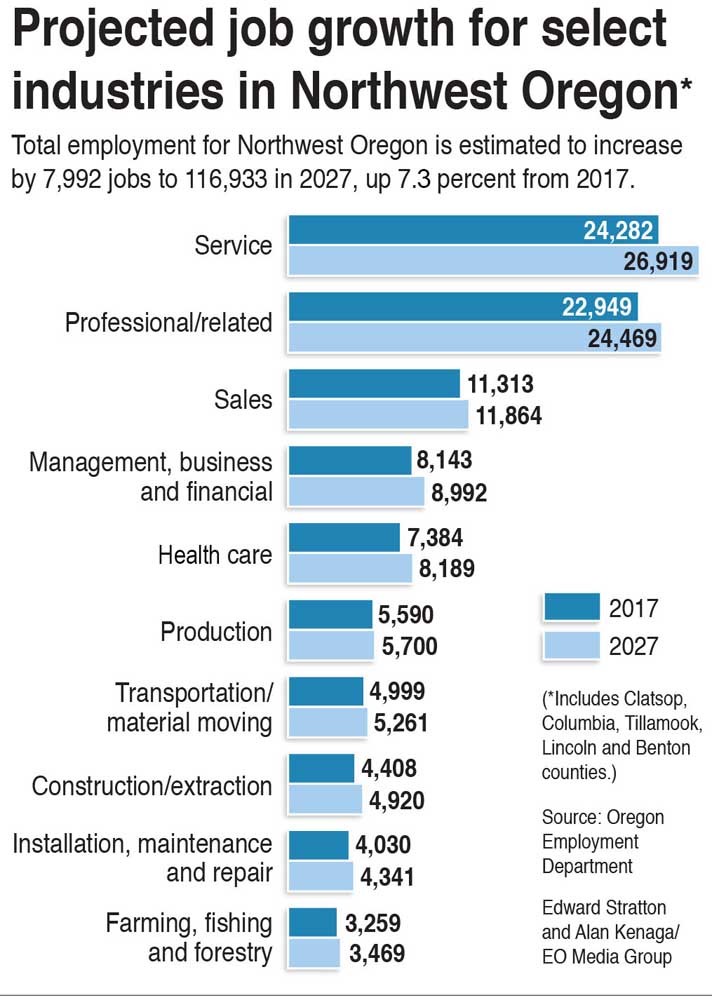In future employment, education will pay
Published 3:47 am Monday, August 6, 2018

- In future employment, education will pay
Northwest Oregon is projected to add nearly 8,000 new jobs through 2027.
But with about 60 percent of vacancies and expansions concentrated in lower-paying jobs that require only a high school diploma or less, earning a family wage will largely depend on education.
The Oregon Employment Department’s biennial job growth projections for Northwest Oregon include Benton, Lincoln, Tillamook, Columbia and Clatsop counties. Benton County, including Corvallis and Oregon State University, has by far the largest population and number of jobs.
Employment in Oregon is expected to grow by 12 percent, or 246,000 jobs, over the next decade, compared to about 7.3 percent in Northwest Oregon.
Erik Knoder, a regional economist covering Northwest Oregon, said slower job growth is common in rural areas.
“Northwest Oregon has a lot of jobs that don’t require a great deal of education or training to get into,” he said. “That’s true of most areas.”
It’s common to have a higher total, expansion and turnover rate in lower-wage jobs, he said.
The service sector alone is expected to account for nearly one-third of the region’s vacancies and expand by more than 2,600 positions over the next decade. Food preparation and serving, with an average wage of $13.27 per hour, is expected to add more than 1,300 jobs. Cleaning and maintenance positions such as maids, housekeepers and janitors, with an average wage of $14.62 per hour, are expected to expand by 600.
The percentage of jobs in farming, fishing and forestry, once dominant industries in the region, are expected to remain below 3 percent of overall employment.
Northwest Oregon is also poised for a nearly 20 percent growth rate in jobs offering wages above $15 an hour, and 28 percent in those requiring at least some post-high school training, from workforce certificates to a bachelor’s degree.
The region is expected to add more than 1,500 professional positions and 850 in the business, management and financial fields over the next decade.
Health care, a steadily growing sector, is expected to expand by another 11 percent in the next decade, with 800 new positions. That includes an estimated 188 more nurses and 79 medical assistants.
Shawna Sykes, a workforce analyst and economist with the state, said local hospitals and other health providers have a continual shortage of nurses, physical therapists and medical assistants because of limited capacity in local training programs.
“As the population ages, those health care positions will continue to grow,” she said.
The state is looking at incorporating a new standard for family self-sufficiency created by a professor at the University of Washington into regional economic analyses, Sykes said. Researchers with the university’s Center for Women’s Welfare calculated the wages and salaries needed for various family sizes to afford housing, food, health care, child care, transportation, taxes and other living costs without public assistance, while having leftover money to save.
In Clatsop County, a single parent with two children would need to earn $36,299 annually to be self-sufficient, according to the report. The cost of self-sufficiency increases to $44,837 for a two-parent household with two kids.
The average wage in the county overall last year was $36,822, according to the state.
Kevin Leahy, head of Clatsop Economic Development Resources, said he was surprised by the projected growth in lower-wage positions but that Clatsop County has a head start educationally.
At least 42 percent of adults in the county have some college, a certificate or a two-year degree, compared to 35 percent statewide. At least 24 percent have a bachelor’s. The state has found that wages increase to more than $38,800 on average with at least some college education, and nearly $40,400 with a two-year degree.
Around half of Clatsop Community College’s students enroll in workforce training programs, compared to students transferring to a university. The college has several flagship career-technical programs in historic preservation, firefighting, welding, automotive, maritime, medical, business and accounting fields.
The college also tries to promote and provide training for good-paying local opportunities, from forest products and fishing to insurance and accounting, Leahy said, especially with much of the workforce approaching retirement.
“Our college needs to focus on jobs that require a higher education, because those are the jobs people need to afford homes,” Leahy said.





